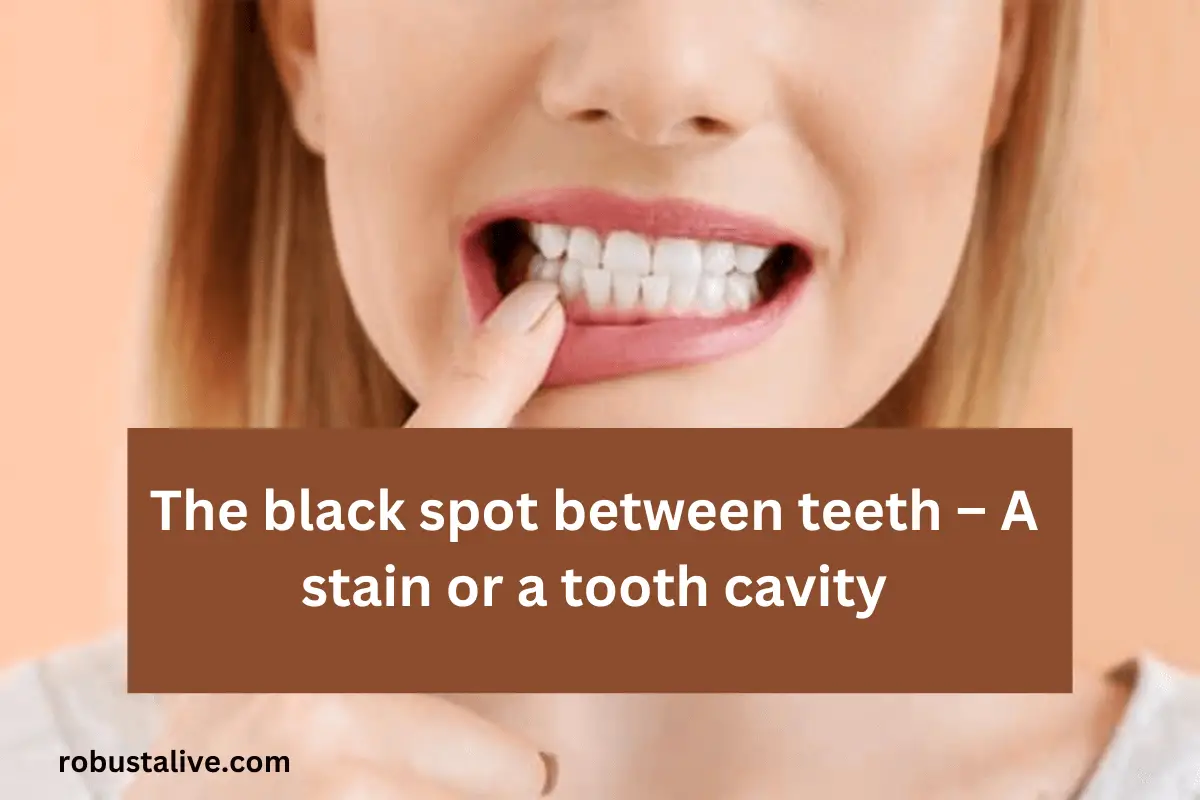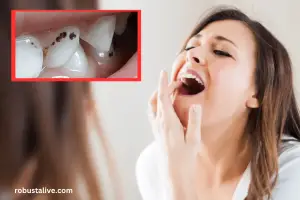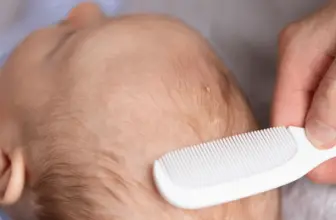The black spot between teeth – A stain or a tooth cavity

Even if you brush and floss your teeth daily, it’s still possible to have spots on your teeth. While some types of discoloration aren’t a primary concern, a grey or black spot between teeth can point towards a significant issue.
If you are taking good care of your teeth and suddenly there is a black spot between them, it’s normal to have a concern. The black spot between teeth can be an indicator of tooth decay. Fortunately, there are many ways to control tooth decay, which can also prevent this from happening.
In this article, I will explain the leading causes behind the dark spots and how to eliminate them. So without any delay, let’s dig in:
What are the Black stains?

Black stains sound like a general term for us, but in cosmetic dentistry, it has a particular meaning. The black spot or line is formed at the neck of the tooth and enters the gums. The thickness and appearance of the spot vary in each case.
The black spot can be dashed or solid; it can be a thick line or maybe disconnected black dots. At first, these stains look like cavities, but they aren’t. But at the same time, they aren’t normal food discoloration related to beverages and foods.
The black lines on the teeth are tartar, which is known as dental calculus. Tartar forms when the oral plaque absorbs the salvia’s minerals and becomes fossilized. Unfortunately, this buildup isn’t easy to remove from the brushing and home procedures. You have to visit the dentist for a professional cleaning.
When the tartar absorbs the minerals, they make these specific black lines. The excessive absorption of copper and iron creates black marks on teeth.
Causes:
Here are the few leading causes behind the black spot between teeth:
- Gum diseases: The main issue with gum disease is that people with gum diseases don’t recognize it, which makes the treatment even more complicated.
- Rough brushing: Brushing your teeth hard can damage the gums and cause regressing, which results in dark spots between the teeth.
- Bone loss around teeth: Our gums trace the shapes of the bones present around the teeth. So when the bone is lost the gums around the teeth slowly start disappearing. When the gums cannot fill the space, they produce empty spaces.
- Teeth shape: Teeth near the lips have large spaces between them. These spaces are filled with gums. There are more chances of a black spot between teeth.
- Tartar: The plaque results in the buildup of a hard substance that makes your teeth look brown or yellow. It appears beside your gums and must be removed by a professional dentist.
- Fluorosis: More than average fluoride intake results in brown pits on the biting side of the teeth. It usually happens on the back molars. Fluorosis can discolor the enamel. Children are more prone to discoloration than adults due to excessive fluoride intake.
- Aging: It is another reason behind the black spot between teeth. With age, the teeth’ enamel starts deteriorating, exposing the inner layer, which results in the yellowish and black spots between teeth.
- Tooth decay: Tooth decay damages the teeth in many different ways. Cavities and the black spot between teeth result from the loss of enamel. Besides, a cavity can deteriorate the enamel, making the internal dentin more prone to cavities. The internal dentil is also naturally darker than the other surface of the teeth. The teeth portion that starts decaying will slowly begin to die and will cause a discolored spot.
- Celiac disease: Celiac disease can prevent the proper development of the tooth enamel that results in translucent enamel or brown, white, or yellow spots.
Grey spots between teeth
Is a specific part of your tooth turning grey? Then in most cases, it’s not a cavity, but it means something different. Here are the few general causes of the grey spots between teeth:
- Tetracycline: It is because of the tetracycline antibiotics used during adult teeth formation. It results in a greyish and blue band on your teeth.
- Tooth trauma includes any impact that disturbs the blood flow to the teeth.
- Aging: Grey teeth shouldn’t be an immediate or emergency concern. To remove the grey color of the teeth, you can use teeth whitening products.
How to get rid of black spots between teeth
There are many ways to get rid of the black spot between teeth. But first, make an initial appointment with your dentist to know the leading cause. Consider following the below methods to remove it.
Dental procedures
If the black spots are because of the cavities or damage due to the injury then there are some specific dental procedures. These specific procedures in such cases include root canals and filling, and based on the severity of the case, you may need a crown.
But for the case of tartar build, you need to go through periodontal therapy or prevention. These therapies will remove the plaque and also remove the stains.
Professional teeth whitening
Staining penetrating the upper layer or the tooth surface requires more robust measures. It includes a professionally recommended whitening process for your teeth. The procedure can be performed in an office or through a take-home method.
Over-the-counter whitening aids
When the black spot between teeth is not because of cavities but due to staining but due to injury, or other causes, then teeth whitening methods can help. Fortunately, for such cases, many over-the-counter medicines can help, including toothpaste with mild abrasives like baking soda or maybe peroxides or whitening strips.
Porcelain veneers
Veneers are best described as shells that are used for the improvement of the front teeth look. Veneers can change the teeth’ color, size, shape, and alignment. They bond with your teeth permanently.
Dental bonding
It is a restorative procedure that involves dental bonding that molds into your teeth with a composite resin. The molding is followed by a procedure that involves polishing the resin to match the natural color of your teeth. But the composite bonding only has durability as long as the porcelain veneers.
How to avoid dark spots on the teeth?
Dark spots on the teeth are common, but we have some specific steps to prevent staining and reduce tooth decay risk. Here are a few tips to help you keep your teeth healthy and in their best position.
- Practice good oral hygiene by flossing two times a day and using a whitening fluoride toothpaste for brushing. Regularly brush your teeth for at least two minutes to get the best result. You can also use a mouthwash with specific ingredients like methanol and eucalyptol. These ingredients can kill menthol, alcohol, eucalyptol, and all the bacteria in your mouth and teeth. But mouthwash is an additional step and should be in place of flossing or brushing.
- Regularly brush your teeth after having drinks and foods that can cause stains or spots on the teeth. The foods include wine, coffee, tea, soda, chocolate, or red sauce.
- Some dentists recommend drinking tooth-staining beverages like tea or coffee with a straw to prevent the liquid’s direct contact with your teeth.
- Make a routine cleaning appointment once every six months.
- Avoid the nicotine products like cigars, pipe tobacco, chewing tobacco, cigarettes, etc.
- Consult your dentist about professional whitening treatment, as you should protect your teeth’ health.
Conclusion
Sometime after the regular flossing and brushing, the spots can still show up on your teeth. But if you have a black spot between your teeth, then it can be a warning of tooth decay. So if you notice any black or dark spot between your teeth, consult your dentist immediately. They will help you know the main cause behind it, which will help you select treatment options.
If your spot is due to tooth decay, your dentist will recommend a root canal, filling, or other solutions. But other in-office or home treatment options are available if the dark spot results from staining from the drinks, nicotine, or other foods.
FAQ’s
Why do I have a dark spot in the crevices of my teeth?
Tooth decay is the most complicated reason behind the black spot on your teeth. When the plaque and tartar accumulate on the teeth and allow the sugar, bacteria, and acid to cling to the teeth, it can result in tartar. Such accumulation can destroy your teeth’ mineral structure and enamel.
How to get rid of the black spots on my teeth?
Fortunately, there are many treatment methods to eliminate the black spots on my teeth. You can visit your dentist, and he will recommend the treatment method according to the condition of the teeth. They may recommend medicated toothpaste, mouthwash, or scaling to remove the black spots.
Can teeth with black spots get fixed?
If the spot is due to tooth decay, your dentist may recommend a filling, root canal, or other treatment option according to the condition. If the dark spots are due to the staining, you can quickly treat them at home.
Can black tartar be removed?
If you have tartar on your teeth, no matter what color it is, immediately visit your dentist to remove it. Your dentist will root plain or clean the tartar with scaling. In the case of black tartar, your dentist will scrap it off above and below the gum line.
What is the cause of black gaps in teeth?
Open gingival embrasures are formed when your gums pull away from the teeth. Many factors result in the formation of these triangular black gaps, including gum diseases, harsh dental hygiene methods, bone loss, or the shape and size of the teeth.
References:
- https://www.healthline.com/health/black-dot-on-tooth
- https://www.healthline.com/health/black-dot-on-tooth#causes
- https://www.medicalnewstoday.com/articles/321777
- https://www.byte.com/community/resources/article/why-black-spots-on-teeth-how-to-remove-them/
- https://grin.deltadentalins.com/archive/2018/fall/how-to-tell-if-i-have-a-cavity/
- https://www.dentistryofwestbend.com/how-to-get-rid-of-a-small-black-spot-on-your-molar/#:~:text=Other%20Causes%20for%20Black%20Spots%20on%20Teeth&text=Tartar%20buildup%20on%20the%20surface,Certain%20medical%20conditions





